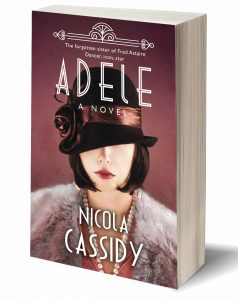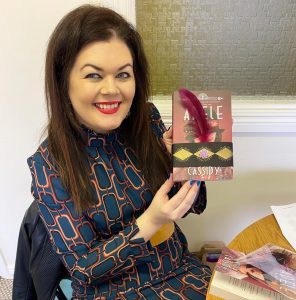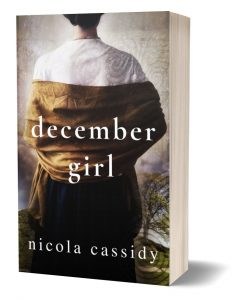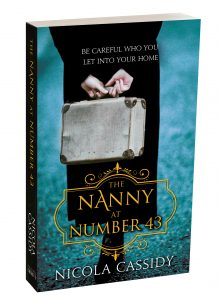
Adele is a bio-fictional account of the life of Adele Astaire, famed dancer, stage star and comedienne of the 1920s. Adele was born in 1896 in Omaha, Nebraska, to hard-working parents Fritz and Johanna Austerlitz. Adele was outgoing and loved to dance – her teacher picked her out as talented at her local dance class and advised her mother to take her to New York, where he felt she could pursue a theatrical career.
At the age of eight and with five year old younger brother Fred in tow, the family set off for stage school and began their training. Soon the children were ready for performance and they developed an act that saw them join the vaudeville ranks, change their name to ‘Astaire’ and travel all over the United States. As teens they trained even further perfecting their professional dancing until they were ready for Broadway. It was the beginning of a hugely successful and financially rewarding stage career for the sibling partnership.

Nicola spent two years researching and writing Adele, using the Astaire archives in Boston, USA, as primary source material and interviewing friends and family who knew Adele personally. She visited Lismore Castle where Adele moved to in 1932 upon her marriage to Charles Cavendish and examined diaries, letters and biographies based on the Astaires.
The book is written in novel form and is interspersed with fictional accounts from people who knew Adele, such as Winston Churchill, Charlie Chaplin and J.M. Barrie.
Nicola uses fictional characters Ellie Morgan who is investigating Adele’s life and Patricia Ryan, a companion of Adele, to help tell Adele’s story. Patricia Ryan is based on a real life Irish companion who accompanied Adele to America in her later years and was her life long friend. Adele was launched in March 2020 and is available in bookstores throughout Ireland and online, worldwide.

December Girl is inspired by two true stories. The first is an eviction that took place at Dowth in 1880 and was the subject of an academic thesis by Slane native Gareth Yore. Yore, published his essay of the newspaper coverage of the case in a journal of local stories and it was this journal that Nicola stumbled across, while researching ideas for a novel. Try as she might, she couldn’t shake the true story of a family evicted wrongfully at the hands of a jealous neighbour.
Nicola took this story and created a fictional family, based on the original Elcock family who lived at Dowth. She added in the Brabazons, a landed gentry family who own the land where the fictional Thomas family live. She used Townley Hall House and Dowth Hall, as inspiration for an imagined country mansion, home to the Brabazons.
In December Girl, Molly has her baby Oliver taken from a pram outside a shop. This story is also inspired by a true baby kidnapping in 1960s Dublin where a childless woman stole a baby as her own and brought her to Belfast to live. The child was eventually returned to her true parents, but the woman managed to keep up the deception for a number of years.
December Girl explores themes of family bond, love and revenge and touches on darker themes of homelessness, prostitution and exploitation. It will appeal to readers who like family sagas, upmarket fiction, historical fiction and TV dramas such as Downton Abbey.

The Nanny at Number 43 was inspired by a number of true stories. The opening of the novel, where two babies are found buried in a suitcase in a garden in Dublin, was taken from a true story of a similar case in late 19th century Drogheda, where a baby was found tucked in suitcase under a bed.
Nicola carried out extensive research into the issue of infanticide and found that it was a common occurrence throughout 19th century Ireland.
The advert placed by William D. Thomas, who hires The Nanny at Number 43, was taken from the Drogheda Conservative newspaper direct, from an issue in January 1880.
The inspiration for the Nanny herself came from two main sources – Mary Ann Cotton, known as the Dark Angel, a Victorian serial killer who poisoned a string of husbands and their children for inheritance and Amelia Dyer, another Victorian serial killer who took in unwanted babies and children and murdered them. It is thought that she may have killed up to 400 children.
Finally, the character of Betty, who has a bird’s eye view of the happenings at Number 43 and an important role to play in the story was inspired by a chance encounter Nicola believes she had with a ghostly figure across the road from 43 Laurence Street. It was this woman who originally gave Nicola the idea to set her fiction in 19th century Drogheda and she hopes her spirit is carried right through the book.